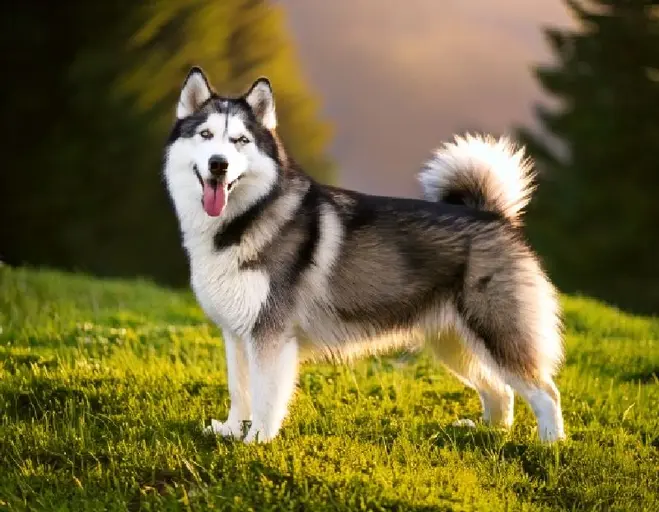The Majestic Alaskan Malamute: A Comprehensive Guide

Brief Introduction to the Alaskan Malamute
The Alaskan Malamute is a powerful and dignified dog, instantly recognizable by its thick double coat, impressive size, and wolf-like appearance. This breed exudes strength, endurance, and a deep-rooted connection to the wild. More than just a pretty face, the Malamute is a hardworking and intelligent companion, bred for pulling heavy loads across vast distances in the harsh Arctic climate. They are loyal and affectionate with their families, but their independent nature and powerful instincts require an experienced owner who can provide consistent training and leadership. The Alaskan Malamute isn’t just a pet; it’s a lifestyle.
The History of the Breed
The Alaskan Malamute’s history is deeply intertwined with the Inuit people of Alaska, specifically the Mahlemut tribe, from whom the breed takes its name.
Origins in the Arctic
The Alaskan Malamute’s origins trace back several thousand years. The Mahlemut people relied on these dogs for survival, using them to haul supplies, hunt game, and protect their settlements. These dogs were not merely working animals; they were integral members of the tribe, treated with respect and care. Selective breeding focused on traits vital for survival in the Arctic: strength, endurance, thick coats, and a cooperative temperament.
Development and Preservation
The breed started to gain wider recognition during the Klondike Gold Rush in the late 19th century. Their strength and stamina made them invaluable for transporting supplies to miners. However, this period also brought the mixing of the Malamute with other breeds, threatening its purity. Dedicated enthusiasts worked tirelessly to preserve the original characteristics of the breed. These efforts included establishing breed standards and registering dogs with kennel clubs.
Modern Role
Today, the Alaskan Malamute is primarily a companion animal, but they still retain their working instincts. They excel in activities like sledding, weight pulling, and hiking. Their historical role has shaped their temperament and physical characteristics, making them a truly unique and remarkable breed.
Appearance of the Alaskan Malamute
The Alaskan Malamute is a striking dog, built for power and endurance. Their physical attributes reflect their purpose as a working breed in harsh environments.
Size and Proportions
* Height: Males typically stand 25 inches tall at the shoulder, while females are slightly smaller at 23 inches. * Weight: Males generally weigh around 85 pounds, and females around 75 pounds. However, larger individuals are not uncommon. * Proportion: The Malamute is a powerfully built dog with a deep chest and strong legs. Its body should be slightly longer than its height.
Coat and Color
* Coat: The Malamute boasts a thick, double coat. The outer coat is coarse and long, while the undercoat is dense and woolly, providing insulation against extreme cold. * Color: Common colors include shades of gray and white, sable and white, black and white, red and white. The only solid color acceptable is solid white.
Head and Facial Features
* Head: The head is broad and powerful but should be proportionate to the body. * Ears: The ears are medium-sized, triangular, and erect, set wide apart on the skull. * Eyes: The eyes are almond-shaped and brown in color. Blue eyes are a disqualification in the breed standard. The expression should be alert and intelligent. * Muzzle: The muzzle is large and tapers slightly from the base to the nose.
Tail
* The tail is bushy and carried over the back, but it should not be tightly curled or touching the back. This is known as a “plume” and is a defining feature of the breed.

Character and Behavior of the Alaskan Malamute
Understanding the Alaskan Malamute’s temperament is crucial for responsible ownership. They are not the right breed for everyone.
Attitude Towards People
Alaskan Malamutes are generally affectionate and loyal to their families. They can be good with children, particularly if raised with them from puppyhood, but supervision is always recommended due to their size and strength. They are known to be less outwardly friendly to strangers compared to other breeds like Golden Retrievers. Early socialization is crucial to ensure they are comfortable around new people.
Interaction with Other Animals
Due to their strong prey drive, Alaskan Malamutes can be challenging to keep with small animals, such as cats and small dogs, especially without proper training and supervision. They often view smaller animals as prey. Introducing them to other animals carefully and gradually from a young age can help, but it’s important to be realistic about their inherent instincts. Same-sex aggression can also be an issue, particularly between males, so careful consideration is needed when introducing them to other dogs.
Activity Level and Exercise Needs
Alaskan Malamutes are high-energy dogs that require a significant amount of exercise. They need daily walks, runs, or other activities to stay physically and mentally stimulated. Without sufficient exercise, they can become destructive and develop behavioral problems. Activities like sledding, weight pulling, agility, and hiking are all excellent outlets for their energy.
Trainability
Alaskan Malamutes are intelligent but independent thinkers. This can make training challenging, as they are not always eager to please. Consistent, patient, and positive reinforcement-based training methods are essential. They respond well to rewards and motivation, but they can be stubborn and easily bored. Professional dog training is highly recommended for Malamute owners, especially those who are new to the breed.
Breed Characteristics
* Independent: They have a strong will and are not as easily swayed as some other breeds. * Intelligent: They are quick learners but require engaging and stimulating training. * Strong-willed: They need a confident and consistent leader. * Diggers: They have a natural instinct to dig, so providing them with a designated digging area can help prevent them from destroying your garden. * Vocal: While not excessive barkers, they often “woo” or howl, especially when excited or lonely.
Care and Maintenance of the Alaskan Malamute
Providing proper care for an Alaskan Malamute requires a commitment to their specific needs.
Grooming Needs
The Malamute’s thick double coat requires regular grooming. * Brushing: They need to be brushed several times a week to prevent matting and tangles. * Shedding: They shed heavily twice a year during shedding season. During this time, daily brushing is essential. * Bathing: They only need to be bathed occasionally, as frequent bathing can strip their coat of its natural oils. * Trimming: They do not require regular haircuts.
Exercise Requirements
* Daily exercise: Aim for at least 1-2 hours of exercise per day. * Variety of activities: Vary their activities to keep them mentally stimulated, such as walks, runs, hikes, and puzzle toys. * Safe containment: Due to their strong prey drive and tendency to roam, they need a securely fenced yard.
Feeding and Nutrition
* High-quality food: Feed them a high-quality dog food formulated for large breeds. * Portion control: Monitor their weight and adjust their food portions accordingly to prevent obesity. * Avoid overfeeding: Overfeeding can lead to health problems, such as hip dysplasia.
Health Considerations
Alaskan Malamutes are generally healthy dogs, but they are prone to certain health problems. * Hip dysplasia: A malformation of the hip joint that can lead to arthritis. * Elbow dysplasia: A similar condition affecting the elbow joint. * Progressive retinal atrophy (PRA): A degenerative eye disease that can cause blindness. * Chondrodysplasia: A genetic disorder affecting bone and cartilage development. * Bloat (Gastric Dilatation-Volvulus): A life-threatening condition where the stomach fills with gas and twists. Know the signs and symptoms and seek immediate veterinary care if suspected.
Breed Weaknesses of the Alaskan Malamute
While loyal and loving, the Alaskan Malamute possesses certain weaknesses that potential owners should be aware of.
Potential for Aggression
While not inherently aggressive towards humans, Alaskan Malamutes possess a strong prey drive and may exhibit aggression towards smaller animals. Same-sex aggression, particularly between males, can also be a concern. Early and consistent socialization and training are crucial to mitigate these risks.
Independent Nature and Stubbornness
Their independent nature can make training challenging. They require an owner who is assertive, consistent, and willing to put in the time and effort to train them properly. Their stubborn streak can be frustrating for inexperienced owners.
High Exercise Needs
Their high energy levels require a significant commitment to exercise. Without adequate physical and mental stimulation, they can become destructive and develop behavioral problems.
Conclusion: Is the Alaskan Malamute Right for You?
The Alaskan Malamute is a magnificent breed with a rich history and a unique personality. They are loyal, affectionate, and intelligent, but they are also demanding and require a dedicated owner who understands their specific needs. This breed is best suited for experienced dog owners who:
- Are active and enjoy spending time outdoors.
- Have a securely fenced yard.
- Are willing to commit to consistent training and socialization.
- Can provide them with the mental and physical stimulation they need.
- Understand and appreciate their independent nature.
If you can provide the Alaskan Malamute with the care, training, and attention they need, you will be rewarded with a loyal and loving companion who will enrich your life for many years to come. However, if you are not prepared to meet their demands, it is best to consider a different breed.
Frequently Asked Questions About Alaskan Malamute
-
Are Alaskan Malamutes good family dogs?
Alaskan Malamutes can be good with families, especially if raised with children from puppyhood. However, supervision is always recommended due to their size and strength. Early socialization is crucial.
-
How much exercise do Alaskan Malamutes need?
Alaskan Malamutes are high-energy dogs and need a significant amount of exercise, aiming for at least 1-2 hours of exercise per day. This can include daily walks, runs, hikes, sledding, or weight pulling.
-
Are Alaskan Malamutes easy to train?
Alaskan Malamutes are intelligent but independent, which can make training challenging. Consistent, patient, and positive reinforcement-based training methods are essential. Professional training is highly recommended.
-
Do Alaskan Malamutes get along with other animals?
Due to their strong prey drive, Alaskan Malamutes can be challenging to keep with small animals. Same-sex aggression can also be an issue. Early and careful introductions are important, but their inherent instincts need to be considered.
-
How much grooming do Alaskan Malamutes require?
Alaskan Malamutes have a thick double coat that requires regular grooming. Brushing several times a week is needed to prevent matting. They shed heavily twice a year, requiring daily brushing during shedding season. Bathing is only needed occasionally.
-
What are some common health problems in Alaskan Malamutes?
Alaskan Malamutes are prone to hip dysplasia, elbow dysplasia, progressive retinal atrophy (PRA), chondrodysplasia, and bloat (Gastric Dilatation-Volvulus).
-
Do Alaskan Malamutes bark a lot?
While not excessive barkers, Alaskan Malamutes often “woo” or howl, especially when excited or lonely.
-
Are Alaskan Malamutes good for first-time dog owners?
Alaskan Malamutes are best suited for experienced dog owners who understand their independent nature and high exercise needs. They require consistent training and leadership.
-
Do Alaskan Malamutes need a fenced yard?
Yes, due to their strong prey drive and tendency to roam, Alaskan Malamutes need a securely fenced yard.
-
Are Alaskan Malamutes aggressive?
While not inherently aggressive towards humans, Alaskan Malamutes possess a strong prey drive and may exhibit aggression towards smaller animals. Same-sex aggression can also be a concern. Early and consistent socialization and training are crucial.

